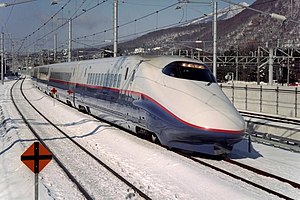Nagano Shinkansen
| Nagano Shinkansen | |||
|---|---|---|---|
 A Nagano Shinkansen E2 series train approaching Karuizawa Station | |||
| Overview | |||
| Owner | JR East | ||
| Locale | Japan | ||
| Termini | |||
| Stations | 6 | ||
| Service | |||
| Type | Shinkansen | ||
| Depot(s) | Nagano | ||
| Rolling stock | E2 series, E7 series | ||
| History | |||
| Opened | 1 October 1997 | ||
| Technical | |||
| Line length | 117.4 km (72.9 mi) | ||
| Track gauge | 1,435 mm (4 ft 8+1⁄2 in) | ||
| Operating speed | 260 km/h (160 mph)* | ||
| |||
The Nagano Shinkansen (長野新幹線) is a Shinkansen high-speed rail line operated by East Japan Railway Company (JR East) between Takasaki and Nagano in Japan. It opened on 1 October 1997, connecting Tokyo and Nagano in time for the 1998 Winter Olympics held in Nagano. The Nagano Shinkansen forms the first section of the planned Hokuriku Shinkansen line currently under construction to Kanazawa, Tsuruga and eventually Osaka.
Services
The Asama trains, named for Mount Asama, an active volcano alongside the line, currently connect Tokyo and Nagano in a minimum of 79 minutes, at a maximum speed of 260 km/h (160 mph)* from Takasaki to Nagano.[1] These services are run by JR East E2 series and E7 series trainsets. There are approximately two services an hour; stopping patterns are varied, with only a few services stopping at all stations. The trains run along the Joetsu and Tohoku Shinkansen lines from Tokyo to Takasaki.
The Nagano Shinkansen services replaced the conventional Shinetsu Main Line limited express services, also named Asama, which previously took 2 hours 50 minutes from Tokyo (Ueno Station) to Nagano. Following the opening of the Shinkansen, part of the conventional line was abandoned between Yokokawa and Karuizawa. This section included the steeply-graded Usui Pass which required the use of bank engines on all trains.
A new island platform serving two tracks was constructed at Tokyo Station to coincide with the Nagano services; this doubled the number of JR East Shinkansen tracks to four, serving the Tohoku and Joetsu Shinkansen lines as well.
Stations
Rolling stock
-
A Nagano Shinkansen E2 series train, June 2002
-
An E7 series train, February 2014
History
The line opened on 1 October 1997.
Between May 2012 and March 2014, station platforms on the Nagano Shinkansen had their platform roofs extended to handle the E7 12-car trains which commenced service ahead of the opening of the Hokuriku Shinkansen.[3] The Hokuriku Shinkansen extension from Nagano to Kanazawa is scheduled to open in March 2015.[3] The 113-km extension from Kanazawa to Tsuruga was approved for construction in June 2012.[4]
From the start of the revised timetable on 15 March 2014, E7 series trainsets were introduced on Asama services.[2] Initially used on seven return services daily, this number is scheduled to be increased to eleven return services daily from 19 April 2014.[2]
References
- ^ "300km/hのトップランナー". Japan Railfan Magazine. 52 (612). Japan: Koyusha Co., Ltd.: p.14 April 2012.
{{cite journal}}:|page=has extra text (help); Unknown parameter|trans_title=ignored (|trans-title=suggested) (help) - ^ a b c 3月15日ダイヤ改正と各地の話題. Tetsudō Daiya Jōhō Magazine (in Japanese). 43 (361). Japan: Kōtsū Shimbun: p.12. May 2014.
{{cite journal}}:|page=has extra text (help); Unknown parameter|trans_title=ignored (|trans-title=suggested) (help) - ^ a b Ito, Tadayuki (3 May 2012). 新幹線ホーム屋根延長へ 長野県内各駅、金沢延伸に備え. The Asahi Shimbun Digital (in Japanese). Japan: The Asahi Shimbun Company. Retrieved 3 May 2012.
{{cite web}}: Unknown parameter|trans_title=ignored (|trans-title=suggested) (help) - ^ Kyodo News, "Bullet-train extensions approved", The Japan Times, 30 June 2012, p. 2
External links







